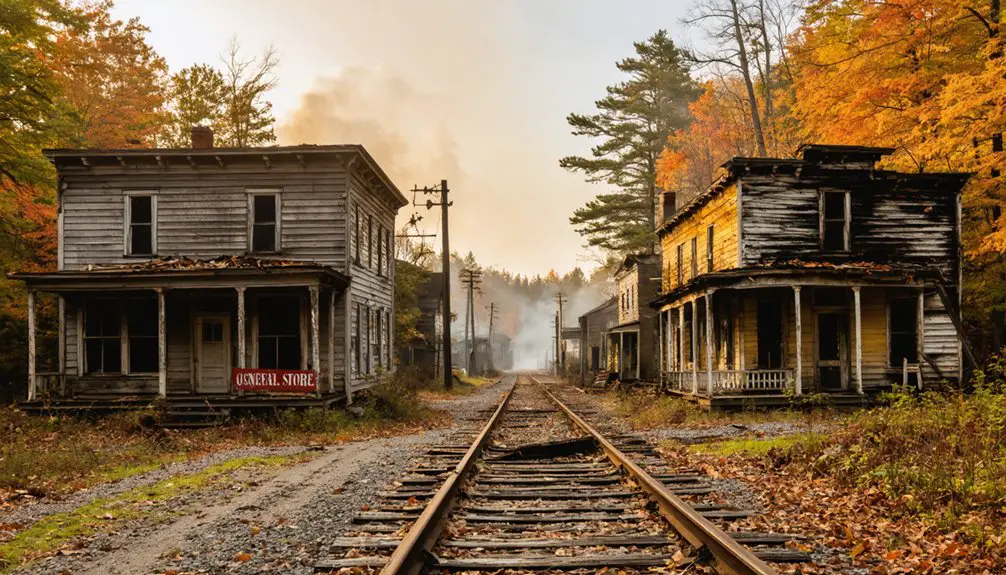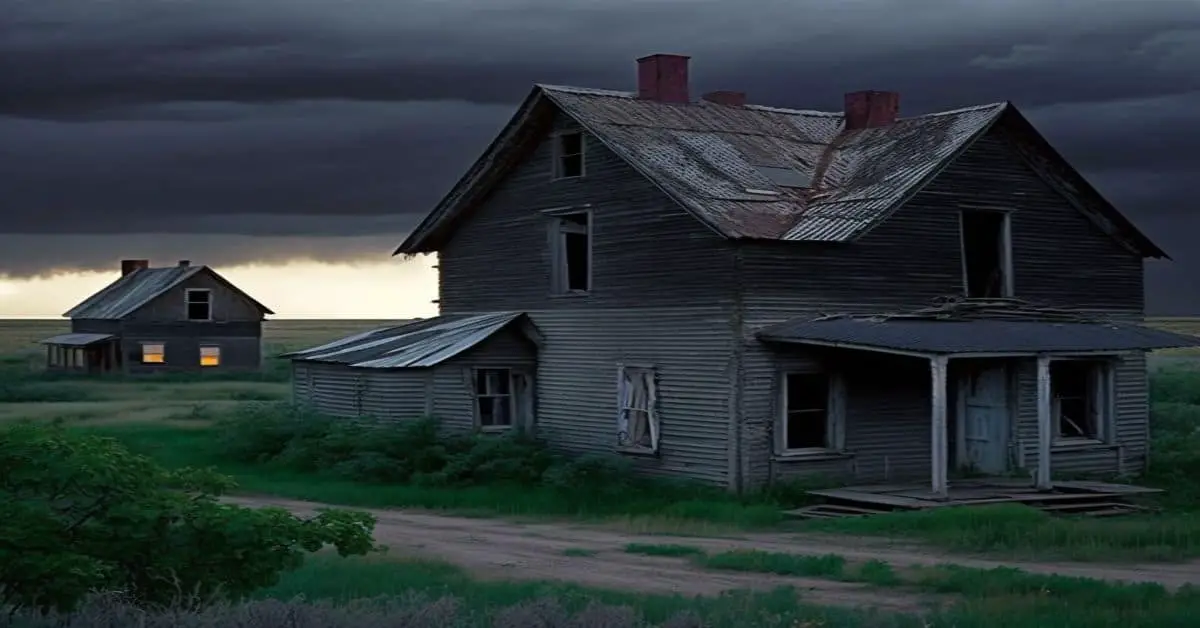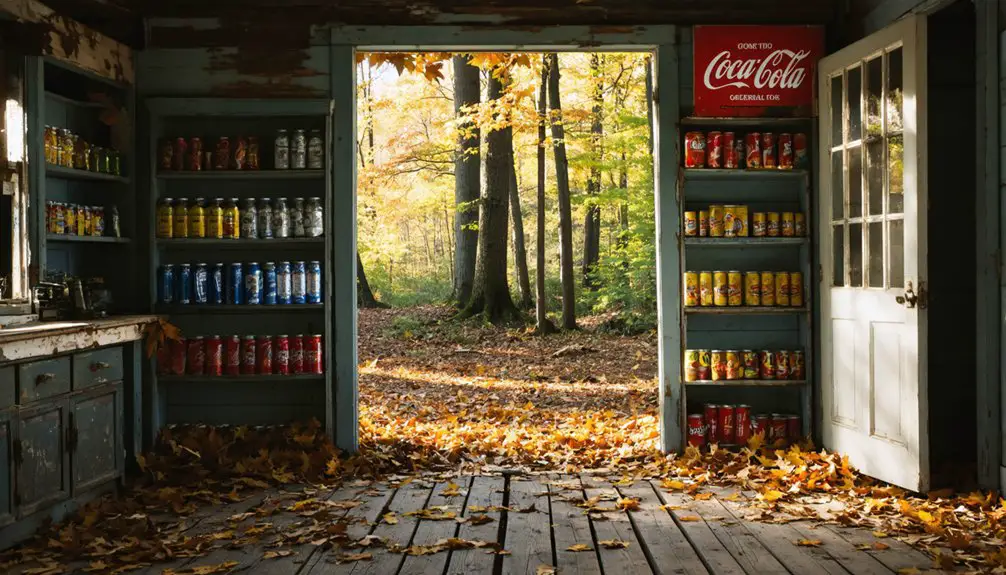You’ll find Riceville’s haunting ruins hidden in Maine’s Hancock County, where a thriving industrial village once produced sole leather from buffalo hides. The town peaked in 1890 with 136 residents centered around its tannery, but tragedy struck in 1905 when a lantern explosion sparked a devastating fire. Shortly after, over 100 residents mysteriously perished, their bodies found swollen along roadsides and in homes. The town’s dark secrets lie buried beneath decades of forest regrowth.
Key Takeaways
- Riceville was a thriving tannery town in Maine’s Hancock County that grew to 136 residents by 1890 before becoming a ghost town.
- A devastating tannery fire in 1905 destroyed the town’s economic foundation, eliminating jobs and forcing residents to abandon their homes.
- Over 100 residents mysteriously died shortly after the fire, with swollen bodies found along roadsides and in homes.
- The town was completely abandoned by 1910, with its post office closing in 1906 as a sign of terminal decline.
- Nature has reclaimed the former town site, with forest growth covering old streets and buildings, leaving only moss-covered ruins visible.
The Rise of a Maine Industrial Village
When the Shaw brothers established a bark extract works in Township 39 of Hancock County, Maine during the 1860s, they laid the foundation for what would become the industrial village of Riceville.
You’ll find that tannery innovations transformed this remote location after Buzzell and Rice purchased the operation in the 1880s, converting it into a specialized sole leather manufacturer using buffalo hides. The tannery utilized environmentally conscious methods, processing leather with naturally occurring tannin from hemlock bark.
The village’s community dynamics evolved rapidly as the workforce grew from just 10 residents in 1880 to 136 by 1890. Supporting the industrial hub, you’d have seen a sawmill, engine house, boarding house, general store, and two farms. Tragically, the village’s prosperity ended when a devastating fire destroyed the tannery in 1906.
Life in the Buffalo Stream Settlement
Life in Riceville centered around the rhythms of the buffalo hide tannery, with 136 residents calling this remote Maine settlement home at its peak in 1890.
In 1890, this remote Maine village hummed with activity as 136 residents lived and worked around the bustling buffalo hide tannery.
You’d find a tight-knit community where social interactions revolved around the schoolhouse, where 21 pupils learned, and the local baseball team that brought residents together for recreation.
While the settlement’s isolation meant you might go weeks without seeing outsiders, especially during winter, you’d have access to daily necessities at the general store. The devastating outbreak of mass casualties left the community in shock and forever changed the town’s destiny.
Community dynamics balanced work and leisure, with the post office connecting you to the outside world and boarding houses welcoming workers and visitors.
The tannery’s operations, processing buffalo hides with local stream water and abundant wood, drove the town’s self-sustaining industrial spirit until its fateful burning in 1905. The F. Shaw and Brothers established the settlement in the 1860s, laying the foundation for what would become Riceville.
The Tannery’s Economic Impact
You’ll find the tannery’s influence on Riceville’s growth was absolute, as it directly employed 25 workers and economically supported all 130-136 residents through various connected enterprises.
The facility’s economic reach extended far beyond local boundaries, processing buffalo hides shipped from distant locations and producing sole leather for New England’s thriving shoe manufacturing industry. To avoid confusion with other locations, place name clarification became essential for historical records.
Through the tannery’s operations, Riceville developed essential infrastructure including worker housing, a general store, and a school that served around 20 pupils. The community’s self-reliance was evident through its isolated location which necessitated maintaining all basic services within the town.
Employment and Local Growth
During its operational years, the Riceville tannery served as the town’s sole economic foundation, employing the entire population of roughly 130 residents by 1890.
The tannery operations weren’t limited to just leather production – they created a complete company town ecosystem.
You’d find a bustling community with a general store, boarding house, and various support businesses all sustained by the economic dependence on the facility.
After operating for over a century, the tannery finally closed its doors in 1997, marking the end of an industrial era for the community.
Raw Materials and Trade
Three essential raw materials formed the backbone of Riceville’s tannery operations: local tree bark for tannin extraction, abundant wood fuel from Maine’s forests, and water from Buffalo Stream.
The tannery’s strategic location gave you access to extensive trade networks. You’d find bark extraction happening right in the surrounding forests, while buffalo hides were imported from distant locations.
The processed sole leather was then shipped to New England’s growing shoe industry, creating a crucial economic link between this remote Maine village and regional markets.
You’ll see how the tannery’s success depended on this perfect balance of local and imported materials. While bark and wood came from nearby forests, the operation’s reach extended far beyond Riceville through established river and rail transport routes.
Mysterious Tales and Local Legends
While many ghost towns fade quietly into history, Riceville’s mysterious demise has spawned some of Maine’s most chilling local legends.
Haunted whispers tell of over a hundred swollen bodies found scattered through the streets in the early 1900s, with no survivors to explain the catastrophe. Established by Shaw and Brothers Company, the town grew around a bustling leather-making operation in the late 1870s. The eerie stillness that followed has captivated generations, as neither disease nor poison was ever confirmed as the cause.
Bodies littered the streets in early 1900s Riceville, their deaths unexplained. The mystery lingered, with neither poison nor disease proven responsible.
You’ll find tales of traders returning to an inexplicably abandoned town, and ghost hunters from Bangor who’ve explored the ruins in 2000 and 2009. In fact, it was a devastating tannery fire in 1906 that marked the beginning of the town’s rapid decline.
While they haven’t confirmed paranormal activity, the site’s tragic history continues to draw urban explorers. Whether victims of tannery toxins or a cholera outbreak, the residents’ sudden disappearance remains one of Maine’s most perplexing mysteries.
The Great Fire and Sudden Exodus

You’ll find the devastating story of Riceville’s end begins with a lantern explosion in the tannery’s roll house on December 30, 1905, which rapidly consumed the industrial complex despite firefighting efforts.
The fire destroyed most of the tannery buildings except for the general store and boarding house, instantly eliminating the sole source of employment for approximately 25 workers and the economic foundation of the entire village. Like the Miramichi Fire of 1825, this blaze brought sudden economic devastation to a Maine community.
Within months, you’d have witnessed the start of a mass exodus as residents abandoned their homes, leading to Riceville’s transformation from a bustling industrial settlement into an overgrown ghost town.
Devastating Blaze Destroys Industry
Late in 1905, a devastating fire erupted from a lantern explosion in the Hancock Leather Co. tannery’s roll house, rapidly consuming the industrial heart of Riceville, Maine.
The tannery explosion destroyed the complex’s key structures, leaving only the general store and boarding house standing.
With the town’s sole employer reduced to ashes and economic dependency on leather production, Riceville’s fate was sealed.
Consider these critical impacts of the disaster:
- The fire overwhelmed firefighting capabilities, destroying specialized buildings for leather production.
- About 25 workers lost their jobs as manufacturing of buffalo sole leather ceased.
- Insurance coverage didn’t lead to rebuilding, unlike a similar incident at their Lowell facility.
- The post office closed in 1906, marking the beginning of Riceville’s transformation into a ghost town.
Mass Migration After Disaster
The devastating tannery fire of 1905 marked only the beginning of Riceville’s tragic demise.
Within weeks, you’d have witnessed an unthinkable mass departure as over 100 residents mysteriously perished, their bodies discovered swollen along roadsides and in homes.
The catastrophe’s unexplained nature forced surviving residents to abandon the town entirely.
Nature Reclaims the Ghost Town
Since Riceville’s abandonment in 1910, nature has steadily reclaimed the former industrial settlement, transforming it into a thriving woodland ecosystem.
Nature’s reclamation began immediately after the town’s desertion, with forest regrowth quickly overtaking streets, buildings, and the old tannery site.
The ecological transformation of Riceville has created diverse habitats where wildlife now flourishes:
- Forest vegetation has engulfed building foundations, with native plants and trees breaking through former streets.
- Buffalo Stream’s wetlands have regenerated, supporting amphibians and aquatic life.
- Decaying structures provide shelter for birds, mammals, and countless invertebrates.
- Soil health has recovered from industrial use, allowing natural plant succession.
You’ll now find moss-covered ruins barely visible through dense undergrowth, as time and nature continue erasing traces of human occupation.
Frequently Asked Questions
Are There Any Remaining Photographs of Riceville During Its Peak Industrial Period?
You won’t find any surviving photographic evidence of Riceville’s industrial heritage during its peak period. The only photos available today show modern ruins rather than the town’s active years.
What Happened to the Machinery and Equipment After the Tannery Burned Down?
You won’t find evidence of machinery salvage or equipment restoration – the tannery’s machinery was effectively destroyed in the 1905 fire, with no records indicating any recovery or reuse efforts.
Were There Any Churches or Religious Buildings in Riceville?
Peculiarly placed and purposefully practical, you won’t find church history or religious buildings in this working village. Records don’t show any established religious structures – residents likely attended services in neighboring towns.
Did Any Descendants of Original Riceville Residents Still Live in Nearby Towns?
You won’t find documented descendant connections in nearby towns after 1912. Local history records don’t track any original Riceville families following the town’s abandonment, with even the Brown family vanishing.
What Native American Tribes Originally Inhabited the Riceville Area Before Settlement?
Where there’s smoke, there’s fire – you’ll find the Wabanaki Confederacy, particularly the Penobscot tribe, maintained cultural heritage in this region, though archaeological evidence near Riceville remains limited and partially undocumented.
References
- https://strangenewengland.com/podcast/the-lost-village-of-riceville-maine/
- http://abandonmentofmaine.weebly.com/home/riceville-revisited
- https://www.youtube.com/watch?v=-QTjvtK8UlI
- https://en.wikipedia.org/wiki/Riceville
- https://www.youtube.com/watch?v=GtEtxQMiyuE
- http://centurymaine.blogspot.com/2014/10/riceville-township-39.html
- https://92moose.fm/maines-ghost-town-the-story-of-riceville/
- https://www.youtube.com/watch?v=NP1pGuDZhgQ
- https://www.bangordailynews.com/2022/07/24/news/midcoast/camden-tannery-growth-fights-joam40zk0w/
- http://www.penbaypilot.com/article/camden-gets-200000-continue-cleaning-former-tannery-land/100987



